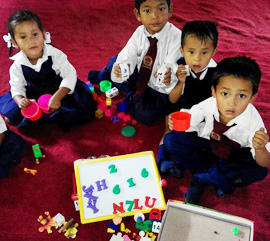Samagra Shiksha envisages the school as a continuum from Pre-School to Senior Secondary levels, also sometimes referred to as K to 12. Pre-school programmes in India are known by different nomenclatures i.e. Anganwadis, Balwadis, nursery school, pre-school, preparatory classes, kindergarten, lower kindergarten (LKG), upper kindergarten (UKG), play centres, crèches, balvatikas etc. Pre-school programmes are offered through government anganwadicentres, pre-schools attached to government schools, private sector schools and civil society organizations.In 2013, Government of India adopted the National ECCE Policy which lays out the vision for children below the age of six years. The Right to Free and Compulsory Education Act (RTE Act) which came into effect in April 2010 also addressed Early Childhood Education under Section 11 of the Act which states “with a view to prepare children above the age of 3 years for elementary education and to provide early childhood care and education for all children until they complete the age of six years, the appropriate Government may make necessary arrangements for providing free pre-school education for such children”. Goal 4.2 of the Sustainable Development Goals 2030 adopted by Government of India states, “by 2030 to ensure that all girls and boys have access to quality early childhood development, care and pre-primary education so that they are ready for primary education”.
Rationale of Early Childhood Care and Education:
The first six years of life are critical since the rate of development in these years is more rapid than at any other stage in an individual’s life. 90% of brain development has already taken place by the time a child is six years of age making the early years a particularly crucial stage for intervention.
As per the Finland’s model on ECE, it is mandatory for children to attend a subsidized early childhood education programme which is based on learning through play. Through studies it is observed that that from birth to age five the brain develops more rapidly than at any other stage of life, and it is also most sensitive to influences from the external environment (such as cognitive stimulation, language development, care, imagination etc).
In the United States, educational researchers used meta-analysis of 22 high-quality experimental studies to assess the impact of ECE on medium and long-term impacts on educational outcomes. It was found that on average, participation in ECE leads to statistically significant grade retention and increases in high school graduation rates. The results support ECE’s utility for promoting child well-being.
Early Childhood Education makes a positive contribution to children’s long-term development and learning by facilitating an enabling and stimulating environment in these foundation years of lifelong learning. Recent evidence from an Indian study confirms that a good quality ECE programme during these critical years can lead to the child’s holistic development, which in turn leads to improved levels of school readiness which finally leads to higher level of learning levels in primary grades. Children that attend pre-school education have higher school completion rates, lower repetition rates, higher score in reading and math and higher labour market productivity.
A study on “The Right Start: Investing in early years of education” conducted by Save the Children, India which suggested the ways to improve the ICDS and Anganwadi centres with special focus on pre-school education. It has been highlighted through the study that ICDS programme lays more emphasis on nutrition, growth monitoring & immunization of children. However, the pre-school education component is neglected in ICDS.
It is observed from the NAS results 2018 report which depicts those students having attended pre-primary schools leads to their higher achievement. In high performing states, 73% students have attended pre-primary schools.
Samagra Shiksha recognizes the need and importance of pre-school education, as has been pointed out in multiple research studies. Quality pre-school education not only increases the progress and achievement of children in primary schools, it also lays the foundation for future growth, learning and development, and also develops positive attitudes and the desire to learn. Therefore, it becomes imperative to provide quality pre-school experiences to children. Under Samagra Shiksha, the pre-school programme is recognized as a critical component of the existing Padhe Bharat Badhe Bharat programme that focuses on foundational learning of early language and literacy and early numeracy in early grades of primary school, thereby recognizing the continuum from pre-school to early grades (classes 1 to 3) of school.
Samagra Shiksha will support the efforts of State Government in providing pre-school education in schools. Pre-school programme will be of upto 2 years duration, for children of theage group 4-6 years. As per UDISE 2015-16, there are 41.3 percent of government primary schools that have a co-located Anganwadi Centre. In case of co-located Anganwadis where the children in the age groupof 3-6 are accommodated, the children of 4-6 age group are considered as pre-school children. As per UDISE 2016-17, out of 12.36 lakh schools with primary sections, 2.94 lakh schools, accounting for 24%, have pre-primary sections. 1.36 crore children are enrolled in pre-primary sections (both the sections) of which only 0.36 crore are in Government schools.
The scheme emphasises safe and secure infrastructure including sanitation facilities; developmentally appropriate curriculum, learning activities, pedagogical practices and assessment; professional development of teachers and community participation and engagement. The scheme lays emphasis on ensuring coordination and convergence with the Ministry of Women and Child Development for curriculum development, capacity building of Anganwadi workers, mentoring and support by school teachers and headmasters, augmenting learning materials.





